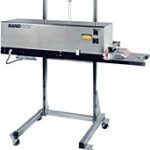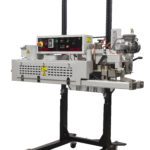Poly (plastic) bag sealers use heat to “melt” the bag closed. Inpak Systems offers three types of commercial poly bag sealers: band sealers, jaw sealers, and hot air sealers.
Band Sealers:
 Band sealers have two bands (belts), typically infused with PTFE to prevent sticking, that hold the top of the bag and carry it between heating elements that seal the bag closed. Band sealers are the best choice for high-volume sealing applications.
Band sealers have two bands (belts), typically infused with PTFE to prevent sticking, that hold the top of the bag and carry it between heating elements that seal the bag closed. Band sealers are the best choice for high-volume sealing applications.
Inpak Systems offers handheld, table top, and free-standing commercial band sealers. Band sealers can be operated in a horizontal, tilted, or vertical position. The vertical position is used if the product can flow out of the bag (i.e. powders, liquids) and the horizontal position is used when the bag can be laid on its side. Depending on the type of bag, industrial band sealers can produce seals from 1/8” to 1/4″ wide at rates up to 50 feet/minute.
For bags weighing over a few pounds, a shelf or conveyor is typically used for support during sealing. Options include bag fillers, printers, coders, embossers, floor stands, bag trimmers, and synchronized bag support conveyors.
More information about band sealers.
Videos of band sealers in action.
Jaw Sealers:
 Jaw sealers have a heating element (bar or wire) that when clamped down on the bag, melts the bag closed. Dual heating elements are used when the bag is especially thick or requires a very high temperature to seal. Jaw sealers can seal bags of most varieties of plastic bags such as polyethylene (PE, HDPE & LDPE), polypropylene (PP, BOPP, MOPP & OPP), PVC, laminations, and cellophane.
Jaw sealers have a heating element (bar or wire) that when clamped down on the bag, melts the bag closed. Dual heating elements are used when the bag is especially thick or requires a very high temperature to seal. Jaw sealers can seal bags of most varieties of plastic bags such as polyethylene (PE, HDPE & LDPE), polypropylene (PP, BOPP, MOPP & OPP), PVC, laminations, and cellophane.
Jaw sealers come with a variety of seal widths and lengths and are available in two versions: impulse or continuous heat sealers.
Impulse sealers use an electrical pulse to temporarily heat the element when it is closed to seal the bag. Most often, impulse sealers are used to seal bags made from polyethylene (PE).
Constant heat sealers sandwich the bag between two pre-heated metal bars. Since heating elements are always hot they can produce a much higher heat allowing the sealer to seal bags with higher melting points such as poly-cellophane, foil, and Mylar bags.
More information about jaw sealers.
Videos of jaw sealers in action.
Hot Air Sealers:
 Hot air sealers are used to seal poly bags and pouches up to 8 mil thick at speeds up to 60 FPM. A hot air sealer uses two belts to pull the bag through the sealer. A heated manifold blows hot air on both sides of the bag and then pressure rollers to seal the bag closed. Hot air sealing eliminates the need for replacing expensive bands.
Hot air sealers are used to seal poly bags and pouches up to 8 mil thick at speeds up to 60 FPM. A hot air sealer uses two belts to pull the bag through the sealer. A heated manifold blows hot air on both sides of the bag and then pressure rollers to seal the bag closed. Hot air sealing eliminates the need for replacing expensive bands.
Inpak Systems offers several commercial hot air sealers which can be free-standing, mounted on a column, or incorporated into bag filling/sealing systems. Hot air sealers are typically used for heavier bags (i.e. >15 lb.) and a synchronized support conveyor is usually used. Options include: flow direction, seal cooler, bag top trimmer, bag top dust flusher, embosser, coder, and bag supporting the conveyor.
